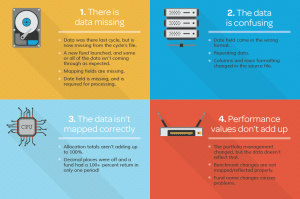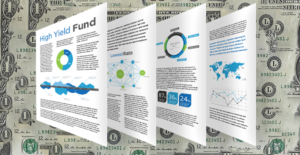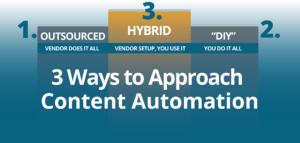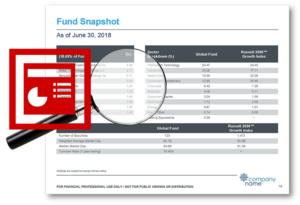Proofreading Fund Documents Doesn’t Have to Be a Drag

A good proofreader is hard to find. Ask any financial services marketer and they will probably tell you this is the worst part of their job – proofreading, editing and updating documents. It’s time consuming work and it takes an enormous amount of time, patience, attention-to-detail, and focus.
Manual proofreading not only requires time and patience, but it also involves thoughtfulness and empathy. Thoughtfulness is required to interpret what is not always an apples-to-apples comparison and empathy is important for evaluating information from the perspective of the end-user. With so many data points and documents to work with, even the most skilled proofreaders face the undeniable challenge of human error. Not to mention, it’s unsatisfying work that takes up time and resources.
The science behind human error
Proofreaders often use a manual spot-checking strategy to determine if the document or report is using bad data. It’s easy to determine this from a spot-check, but if all of your numbers are wrong, the process that put them there in the first place is probably broken.
What about localized errors? That is, those that are not attributable to a systemic problem and are most likely introduced by human error. Let’s say 1 out of 100 numbers is wrong and a proofreader spot-checks 10% of them. For each number checked, there is a 1-in-a-1000 chance that it’s one of the problematic ones. So if a proofreader looked at 10 numbers in each of 100 documents, could he or she feel confident in the numbers? There’s actually a 37% chance of completely missing all errors*, and that’s presuming that a good proofreader recognized a bad number when he or she checked it. (* Combinatorics: chance that one checked number is a good one =.999 For 1000 test cases, the chance of finding all good numbers = .9991000 = .367 = 37%)
In a nutshell, this illustrates that proofreading is difficult and unreliable at best. When data problems are not systemic, spot-checking is not even a valid approach as there is a high probability of missing errors. In a highly regulated industry such as financial services, asset management marketers are under a lot of pressure to produce documents that are accurate and consistent. In order for proofreading to be reliable, technology solutions can be applied to greatly reduce human error.
Automated Data Validation
Automated data validation, when set up properly, can be much more effective than manual proofreading. Computers were built for doing those tedious, repetitive, and detail-oriented tasks. But what about the thoughtfulness and empathy that real-life proofreaders offer? Surely technology can’t replicate these skills. Or can it?
Thoughtfulness actually can be encoded into data validation logic. For example, you can compare numbers to analogous historical figures and validate that they are within an expected range of variance (which can be measured by looking further back into historical data). You can most certainly use this technique to validate that you have all the data-points you are expecting in the first place.
It’s often difficult to anticipate all the issues that might arise in your data flow. In fact, if you anticipate an issue, you can usually figure out a way to handle it so that it never becomes a problem. It’s the unanticipated issues that make proofreading a requirement. And that’s because good proofreading makes no presumptions about how the data got there.
But being free of presumptions is not unique to good proofreading. Automated data validation can be designed in the same thoughtful and non-presumptuous way. The key to doing this is to construct your validation so that it applies new business rules (aka thoughtfulness) to your data. This way, you are cross-checking a different path to the data in your report or document. Sometimes this is done by using alternate sources, but that’s not always necessary. We technology gurus know a few tricks to generate some form of a true apples-to-apples comparison, which can then be used to produce an “exception” report.
When data validation automation is applied, the manual task of proofreading has been reduced to a much simpler task. Now, a proofreader is only looking at a handful of data points that have already been identified as possibly problematic. This makes proofreading much easier, faster, and less prone to human error. Plus, it takes the dread out of proofreading and frees-up your time for more value-added work.
A good proofreader is hard to find. But, with a good technology solution in place you might not need one.
Thanks for reading! You can connect with Noah Menikoff on LinkedIn.
Want to learn more about data automation validation? Click here.
Here are some related resources that might interest you: From the Blog: Fund Data Automation Solves Four Common Data Problems Faced by Fund Marketers |  From the Blog: How much does it cost to automate factsheets? 🧐 |  From the Blog: The 3 Ways to Approach Content Automation |




 Compare the Top 3 Finserv Content Automation Vendors [White paper]
Compare the Top 3 Finserv Content Automation Vendors [White paper] Create Pitchbooks the Drive Sales [White paper]
Create Pitchbooks the Drive Sales [White paper] Build vs. Buy: Should Your Financial Services Firm Outsource or Insource Marketing Technology? [White paper]
Build vs. Buy: Should Your Financial Services Firm Outsource or Insource Marketing Technology? [White paper]  10 Tips for Rebranding your Fund Marketing Documents [White paper]
10 Tips for Rebranding your Fund Marketing Documents [White paper]




